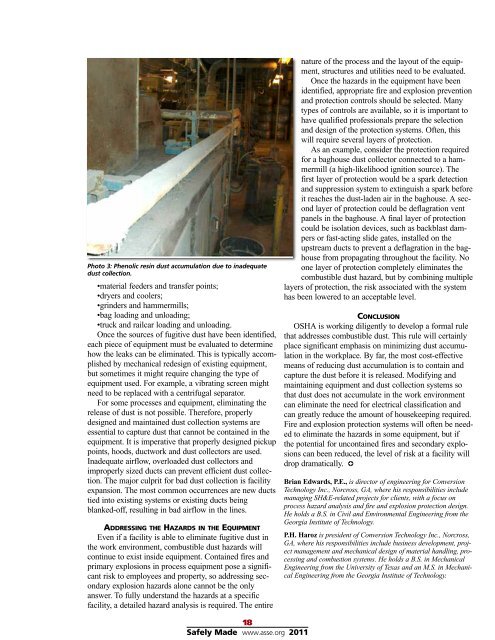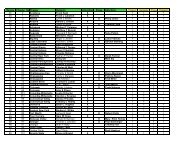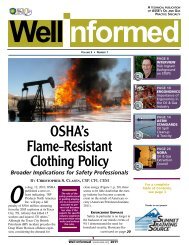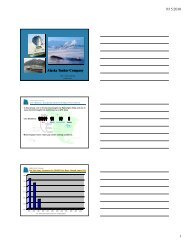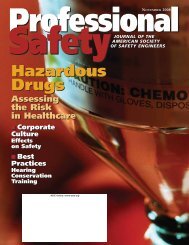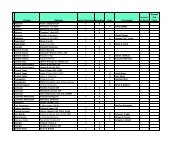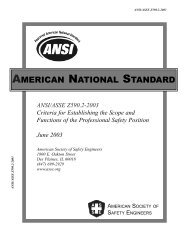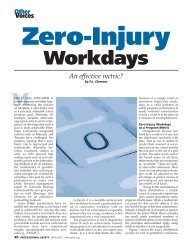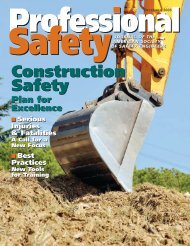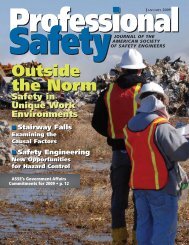Safety & Health Effects of Shift Work - ASSE Members
Safety & Health Effects of Shift Work - ASSE Members
Safety & Health Effects of Shift Work - ASSE Members
You also want an ePaper? Increase the reach of your titles
YUMPU automatically turns print PDFs into web optimized ePapers that Google loves.
Photo 3: Phenolic resin dust accumulation due to inadequate<br />
dust collection.<br />
•material feeders and transfer points;<br />
•dryers and coolers;<br />
•grinders and hammermills;<br />
•bag loading and unloading;<br />
•truck and railcar loading and unloading.<br />
Once the sources <strong>of</strong> fugitive dust have been identified,<br />
each piece <strong>of</strong> equipment must be evaluated to determine<br />
how the leaks can be eliminated. This is typically accomplished<br />
by mechanical redesign <strong>of</strong> existing equipment,<br />
but sometimes it might require changing the type <strong>of</strong><br />
equipment used. For example, a vibrating screen might<br />
need to be replaced with a centrifugal separator.<br />
For some processes and equipment, eliminating the<br />
release <strong>of</strong> dust is not possible. Therefore, properly<br />
designed and maintained dust collection systems are<br />
essential to capture dust that cannot be contained in the<br />
equipment. It is imperative that properly designed pickup<br />
points, hoods, ductwork and dust collectors are used.<br />
Inadequate airflow, overloaded dust collectors and<br />
improperly sized ducts can prevent efficient dust collection.<br />
The major culprit for bad dust collection is facility<br />
expansion. The most common occurrences are new ducts<br />
tied into existing systems or existing ducts being<br />
blanked-<strong>of</strong>f, resulting in bad airflow in the lines.<br />
ADDRESSING THE HAZARDS IN THE EQUIPMENT<br />
Even if a facility is able to eliminate fugitive dust in<br />
the work environment, combustible dust hazards will<br />
continue to exist inside equipment. Contained fires and<br />
primary explosions in process equipment pose a significant<br />
risk to employees and property, so addressing secondary<br />
explosion hazards alone cannot be the only<br />
answer. To fully understand the hazards at a specific<br />
facility, a detailed hazard analysis is required. The entire<br />
nature <strong>of</strong> the process and the layout <strong>of</strong> the equipment,<br />
structures and utilities need to be evaluated.<br />
Once the hazards in the equipment have been<br />
identified, appropriate fire and explosion prevention<br />
and protection controls should be selected. Many<br />
types <strong>of</strong> controls are available, so it is important to<br />
have qualified pr<strong>of</strong>essionals prepare the selection<br />
and design <strong>of</strong> the protection systems. Often, this<br />
will require several layers <strong>of</strong> protection.<br />
As an example, consider the protection required<br />
for a baghouse dust collector connected to a hammermill<br />
(a high-likelihood ignition source). The<br />
first layer <strong>of</strong> protection would be a spark detection<br />
and suppression system to extinguish a spark before<br />
it reaches the dust-laden air in the baghouse. A second<br />
layer <strong>of</strong> protection could be deflagration vent<br />
panels in the baghouse. A final layer <strong>of</strong> protection<br />
could be isolation devices, such as backblast dampers<br />
or fast-acting slide gates, installed on the<br />
upstream ducts to prevent a deflagration in the baghouse<br />
from propagating throughout the facility. No<br />
one layer <strong>of</strong> protection completely eliminates the<br />
combustible dust hazard, but by combining multiple<br />
layers <strong>of</strong> protection, the risk associated with the system<br />
has been lowered to an acceptable level.<br />
CONCLUSION<br />
OSHA is working diligently to develop a formal rule<br />
that addresses combustible dust. This rule will certainly<br />
place significant emphasis on minimizing dust accumulation<br />
in the workplace. By far, the most cost-effective<br />
means <strong>of</strong> reducing dust accumulation is to contain and<br />
capture the dust before it is released. Modifying and<br />
maintaining equipment and dust collection systems so<br />
that dust does not accumulate in the work environment<br />
can eliminate the need for electrical classification and<br />
can greatly reduce the amount <strong>of</strong> housekeeping required.<br />
Fire and explosion protection systems will <strong>of</strong>ten be needed<br />
to eliminate the hazards in some equipment, but if<br />
the potential for uncontained fires and secondary explosions<br />
can been reduced, the level <strong>of</strong> risk at a facility will<br />
drop dramatically. <br />
Brian Edwards, P.E., is director <strong>of</strong> engineering for Conversion<br />
Technology Inc., Norcross, GA, where his responsibilities include<br />
managing SH&E-related projects for clients, with a focus on<br />
process hazard analysis and fire and explosion protection design.<br />
He holds a B.S. in Civil and Environmental Engineering from the<br />
Georgia Institute <strong>of</strong> Technology.<br />
P.H. Haroz is president <strong>of</strong> Conversion Technology Inc., Norcross,<br />
GA, where his responsibilities include business development, project<br />
management and mechanical design <strong>of</strong> material handling, processing<br />
and combustion systems. He holds a B.S. in Mechanical<br />
Engineering from the University <strong>of</strong> Texas and an M.S. in Mechanical<br />
Engineering from the Georgia Institute <strong>of</strong> Technology.<br />
18<br />
Safely Made www.asse.org 2011


